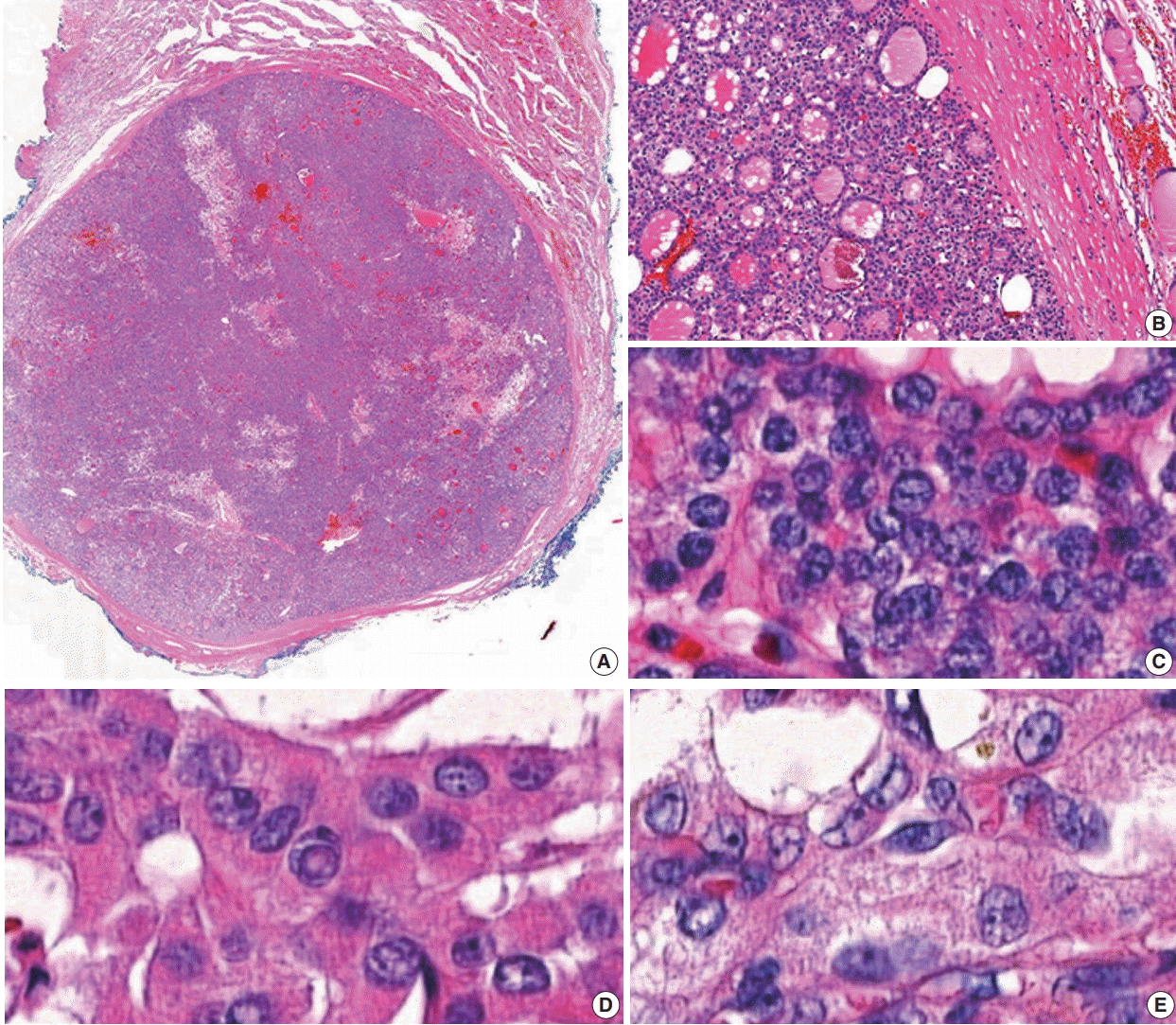Abstract
Background
Methods
Results
Notes
Author contributions
Conceptualization: SWH, CKJ.
Data curation: JYS, JHP, JYP, YJC, CKJ.
Formal analysis: JYS, JHP, JYP.
Funding acquisition: SWH.
Investigation: JYS, JHP, JYP, YJC, CKJ, DES, JJK, SYP, HYN, JHK, JYS, HSK, SWH.
Methodology: JYS, JYP, YJC, CKJ, SWH.
Project administration: CKJ, SWH.
Resources: JYS, JYP, YJC, CKJ, DES, JJK, SYP, HYN, JHK, JYS, HSK, SWH.
Supervision: CKJ, SWH.
Validation: JYS, JYP, YJC, CKJ, SWH.
Visualization: JYS.
Writing—original draft: JYS, CKJ, SWH.
Writing—review & editing: JYS, CKJ, SWH.
Conflicts of Interest
CKJ and SYP, editors-in-chief of the Journal of Pathology and Translational Medicine and SWH, an editorial board member of the Journal of Pathology and Translational Medicine, were not involved in the editorial evaluation or decision to publish this article. All remaining authors have declared no conflicts of interest.
REFERENCES
Fig. 1.

Table 1.
Table 2.
| Total | ≥ 1.0 cm | < 1.0 cm | |
|---|---|---|---|
| All cases of NIFTP | 238 (1.3) | 152 (0.8) | 86 (0.5) |
| NIFTP alone | 174 (73.3) | 125 (82.2) | 49 (57.0) |
| NIFTP coexisting with malignancy | 64 (26.7) | 27 (17.8) | 37 (43.0) |
Table 3.
| Overall | Before NIFTP introductiona | After NIFTP introduction | p-value | |
|---|---|---|---|---|
| Prevalence of NIFTP | 125/18,819 (0.7) | 66/9,656 (0.6) | 59/9,163 (0.7) | .739 |
| Sex | .004 | |||
| Male | 32 (25.6) | 24 (36.4) | 8 (13.6) | |
| Female | 93 (74.4) | 42 (63.6) | 51 (86.4) | |
| Age, mean ± SD (range, yr) | 46.7 ± 12.5 (23–73) | 47.9 ± 13.1 (23–73) | 45.3 ± 11.9 (25–73) | .238 |
| Tumor size, median (range, mm) | 26.2 (10–80) | 24.5 (10–61) | 28.0 (10–80) | .195 |
| No. of paraffin blocks, median (range) | 5.3 (1–26) | 5.2 (2–26) | 5.5 (1–18) | .398 |
| Lymph node dissection | .385 | |||
| Performed | 101 (80.8) | 48 (72.7) | 53 (89.8) | |
| Not performed | 24 (19.2) | 18 (27.3) | 6 (10.2) | |
| Lymph node metastases | > .99 | |||
| Positive | 0 | 0 | 0 | |
| Negativeb | 125 (100) | 66 (100) | 59 (100) | |
| Surgical procedure | .021 | |||
| Lobectomy or isthmectomy | 81 (64.8) | 37 (56.1) | 44 (74.6) | |
| Total thyroidectomy | 44 (35.2) | 29 (43.9) | 15 (25.4) | |
| Lymphatic invasion | 1.000 | |||
| Positive | 0 | 0 | 0 | |
| Negative | 125 (100) | 66 (100) | 59 (100) | |
| Vascular invasion | 1.000 | |||
| Positive | 0 | 0 | 0 | |
| Negative | 125 (100) | 66 (100) | 59 (100) | |
| Distant metastasis | 1.000 | |||
| Positive | 0 | 0 | 0 | |
| Negative | 125 (100) | 66 (100) | 59 (100) | |
| Postoperative radioactive iodine therapy | .365 | |||
| Performed | 29 (23.2) | 17 (25.8) | 12 (20.3) | |
| Not performed | 96 (76.8) | 49 (74.2) | 47 (79.7) | |
| Follow-up, median ± SD (range, mo) | 25.1 ± 19.1 (0–60) | 36.2 ± 14.5 (0–60) | 10.7 ± 6.6 (1–24) | |
| Recurrence of disease | 1.000 | |||
| Positive | 0 | 0 | 0 | |
| Negative | 125 (100) | 66 (100) | 59 (100) |
Table 4.
| Mutation | No. (%) |
|---|---|
| BRAFV600E | |
| Present | 0 |
| Absent | 27 (100) |
| All RAS mutation | |
| Present | 15 (55.6) |
| NRAS | 6 (22.2) |
| c.181C > A (p.Gln61Lys) | 3 (50.0) |
| c.182A > G (p.Gln61Arg) | 3 (50.0) |
| HRAS | 6 (22.2) |
| c.182A > G (p.Gln61Arg) | 6 (100) |
| KRAS codon 61 mutationa | 3 (11.1) |
Table 5.
| Study | Period | Diagnostic criteria | PTC | NIFTP |
No. (%) |
|||
|---|---|---|---|---|---|---|---|---|
| BRAFV600E mutation | RAS mutation | Lymph node metastasis | Distant metastasis | |||||
| Cho et al. (2017) [17] | 2008–2014 | < 1% papillae | 6,269 | 105 | 10 (10.0) | - | 3 (2.9) | 1 (1.0) |
| 0% papillae | 6,269 | 95 | 0 | 48/89 (53.9) | 2 (2.1) | 0 | ||
| Kim et al. (2017) [28] | 2009–2014 | < 1% papillae | 6,548 | 43 | 3 (7.0) | - | 1 (2.3) | 0 |
| Lee et al. (2017) [18] | 2010–2014 | < 1% papillae | 769 | 21 | 5 (23.8) | 12 (57.1) | 1 (4.7) | 0 |
| Kim et al. (2018) [30] | 2011–2012 | < 1% papillae | 1,411 | 2 | 0 | - | 0 | 0 |
| Kim et al. (2018) [31] | 2013–2016 | 0% papillae | - | 32 | 0 | 15 (46.9) | 0 | 0 |
| Kim et al. (2018) [29] | 2014–2016 | < 1% papillae | 2,853 | 73 | 9 (12.3) | 36 (49.3) | 9 (12.3) | 0 |




 PDF
PDF Citation
Citation Print
Print



 XML Download
XML Download